South Africa’s biggest national park has 13 campsites, each with something different to offer. Melanie van Zyl pitched her tent from south to north to find the best.

The Berg-en-Dal Rest Camp is named for the scenic drives that climb koppies and dip into the valleys of the area. Image; Melanie van Zyl
I first learnt to swim without armbands in the pool at Bergen- Dal rest camp when I was six.
I also used to do ‘game drives’ sitting on my dad’s lap in the car and steering the wheel towards impala, giraffes and more. Dad could ‘smell’ a zebra from kilometres away, with those superpowers only parents seem to have – much to my and my sister’s delight. (Said sister once took a giant swig of gin when my folks failed to pack any juice for us on our afternoon drive, but remembered their own tonics and decanted some gin into a water bottle.)
Kruger is also where I learned how to identify birds: my first, the colourful lilac-breasted roller. Kruger National Park was founded 120 years ago and stretches for 350 kilometres, from Mpumalanga in the south, sweeping along the Mozambique border to where South Africa, Zimbabwe and Mozambique meet at the Limpopo River in the north. Today it’s one of the most accessible wildlife experiences in Africa and, at two million hectares big, with an impressive range of wildlife, habitats, birds and views, you can return to a new experience every trip.
I camped my way from Malelane right up to Punda Maria, rating and assessing every rest camp on the way. It was hard not to put every campsite on my final list, but this is how I would plan my own affordable camping trip.
KNP stats
147 mammal species; 250 wild dogs; 12 000 elephants; 508 bird species; 114 reptile species; 49 fish species; 34 amphibian species; 18 spider species (more than any other park in SA).
Costs
From R285 for two people at all camps except Punda Maria and Satara (which charge from R240), and up to R330 in peak season. Each campsite can sleep maximum six, and it’s R88 for each additional adult. The base rates include one vehicle per site; each additional vehicle costs R85 a night. The park conservation fee is R82 per person (R41 kids) or you can purchase a Wild Card and get entry for a full year to all SA parks for R565. sanparks.org
1. Berg-en-dal rest Camp

Berg-en-Dal Rest Camp. Image: Melanie van Zyl
Closest gate: Malelane
Sites: 82
Best feature: Family-friendly and beautiful hilly surrounds
Special Sightings: Elephants, leopard tortoises, klipspringers
The south can get really crowded. Despite being a big camp, Berg-en-Dal is ringed by lovely natural scenery in a mountainous environment and feels quite chilled out. On the northern and southern sides, dry riverbeds border the camp, with large trees alongside. The best sites are along the fence with views over these and green koppies and of big mammals (elephants and rhinos are commonly seen through the wire).
These spots get snapped up quickly, though. If you’re here for a weekend, get to the camp early to secure a spot, then go out for your drive. (All the good ones were taken by the time I arrived at 5pm.) Also, not all sites are level so I was grateful for my little tent with its small footprint.
The calls of lively woodland kingfishers and the more eerie spookvoël echo through the trees, and it’s a paradise for children who can escape to the pool or chase each other around the jungle gym. It’s an easy camping experience with ample ablution blocks, clothes lines, electric urns for hot water and two-plate stoves if you’re sick of braaiing (or it’s raining).

The Berg-en-Dal Rest Camp is named for the scenic drives that climb koppies and dip into the valleys of the area. Image; Melanie van Zyl
It’s an older camp and needs some love, but there’s a good dam in front of the restaurant and a boundary trail that winds its way around the camp. Leopards and wild dogs are found regularly in the area; lions are usually seen in the lower plains on the roads to Skukuza and Crocodile Bridge.
Do this Meander to Afsaal picnic site via the scenic Matjulu Loop on the S110 and S120 roads – it weaves through granite koppies with excellent views. Pack eggs and bacon to fire up a skottel (rent one for R25 for half an hour) at the picnic site, and look out for the resident hyena that lurks in the nearby riverbed. Cheetah and lion sightings in the area are fairly common too; chat to other picnickers for tips on where to go after breakfast.
2. Crocodile Bridge Rest Camp

Crocodile Bridge Rest Camp. Image: Melanie van Zyl
Closest gate: Crocodile Bridge
Sites 20
Best feasture One of the closest camps to Gauteng, and great for wildlife
Special sightings The Big Five
On the southern border of the park, Malelane satellite camp is also lovely but overlooks sugar-cane fields, which is why I prefer Crocodile Bridge. It’s in one of the busiest areas of the park, where plains game gather and water is better retained, but there are just 20 shaded sites in this small camp.
It’s perfect for a weekend away (being right at the park gate) and in a productive game-watching area – we saw lions mating just three kilometres from the camp, and I loved watching the redbilled queleas flocking home in huge waves at sunset from the surrounding farms.
Bushbabies nest in the hollows of fence poles, so watch for their big eyes and ears peeking out. All sites have power and we camped on the fence, next to tented unit number 8. (There are eight of these, and it’s a great budget option if you don’t want to pitch camp on the first or last night of your trip. From R640 for two).
Do this Drive the tarred H4-2 to Lower Sabie and take time to look along the river for leopards. Lower Sabie has a beautiful restaurant overlooking the Sabie River – perfect for coffee or lunch. And on your way back, be sure to sit for a while at Sunset Dam just outside the camp gate to see buffalo, hippos, crocs and waterbirds. Book ahead for a guided sunset drive (R325 per person); it can be difficult to get a spot as they also take bookings from lodges outside the park.
Plus What I like about Malelane satellite camp is that it can only be accessed by residents and has no traffic racing by, so it has a peaceful feel. The spacious sites (most of them positioned on the fence) are beneath marula trees.
3. Lower Sabie Tented Camp
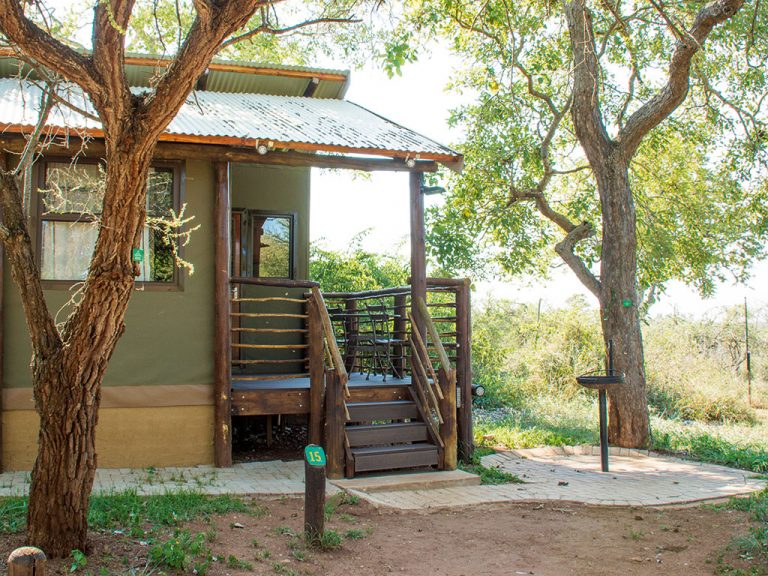
Lower Sabie Tented Camp. Image: Melanie van Zyl
Closest gate: Crocodile Bridge
Tents 29
Best feasture The Sabie River
Special sightings Leopards, hippos, buffalo
Lower Sabie is a great rest camp in an amazing game zone in the park – the riverine area is rich in lions, cheetahs, elephants, hippos and herds of buffalo (up to 800 in number) and a very high density of warthogs – but it’s not my top choice for camping. There are very small stands, none are beside a fence for views and only some sites have precious shade. It’s a pity because there aren’t many options here in mid-Kruger; the Skukuza sites are not great either. Rather spend your money on Lower Sabie’s safari tents that have just been revamped, sporting fresh interiors, an en-suite bathroom and a closed-off kitchen (better for warding off the monkeys!).
Although only five are available at the moment (units 1 to 5), many boast beautiful river views. Units 15, 16 and 17 are in the best location, with privacy in the corner of the camp, and they should be open from May. From R1340 for two.
Do this Drive the triangular route between Tshokwane and Skukuza via the H4-1, H1-2 and H10. There are plenty of picnic spots, waterholes and viewpoints for watching birds and beasts. It’s often busy with game-drive operators from outside the park, for good reason.
Tip Hooded vultures and tawny eagles are the best raptor indicators for a kill and often point to a fresh carcass. Look out for them perched in the trees.
4. Maroela Satellite Camp
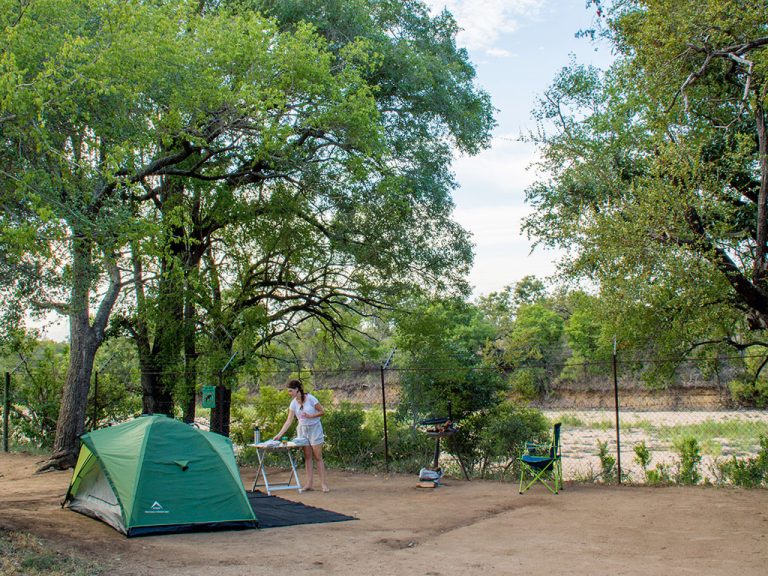
Maroela Campsite. Image: Melanie van Zyl
Closest gate: Orpen
Sites 20
Best feasture Riverbed views
Special sightings Predators, honey badgers
Satara is a very popular campsite, with a pool, shop, restaurant, the famous S100 road and the ‘killing fields’ on the H1-4, all well-known for good predator sightings. However, Maroela is the campsite in this region that I’ll return to because it’s small (Satara is the second-biggest camp in the park after Skukuza) and is set on the dry Timbavati riverbed in an incredibly relaxed atmosphere – until the resident honey badger pays a visit!
Just two kilometres from the Orpen Gate but set back into the bush so there’s no passing traffic, it has electricity and a communal kitchen. Bushbuck tiptoe between sites and Natal spurfowl scratch around your camp chair. The sites beside the riverbed are best, but there are also some on the fence that look out into bush; there’s a communal viewpoint overlooking the riverbed if you feel you’re missing out.
You can easily while away an afternoon in your campsite below bushwillow and leadwood trees inhabited by purplecrested turacos – just beware of baboons and badgers. They are notorious for causing havoc here, so keep all your food locked in the car and not in your tent (or they’ll wreck it trying to get in).
Do this The H7 road, from Orpen Gate to Satara, is a great drive for seeing plains game like zebra and thus also good for spotting cheetahs and other predators. The trees along the Timbavati River often host lazy leopards, so be sure to look up.
Plus Nearby, Tamboti tented camp is also exceptional. All tents line the dry Timbavati River and have a small deck beside the boundary fence and a braai area with great views. There are 30 budget tents (15 are two-bed, the others sleep four), with communal ablutions and kitchen facilities. Bring your own eating utensils, pots and pans. From R610 for two.
5. Balule Satellite Camp
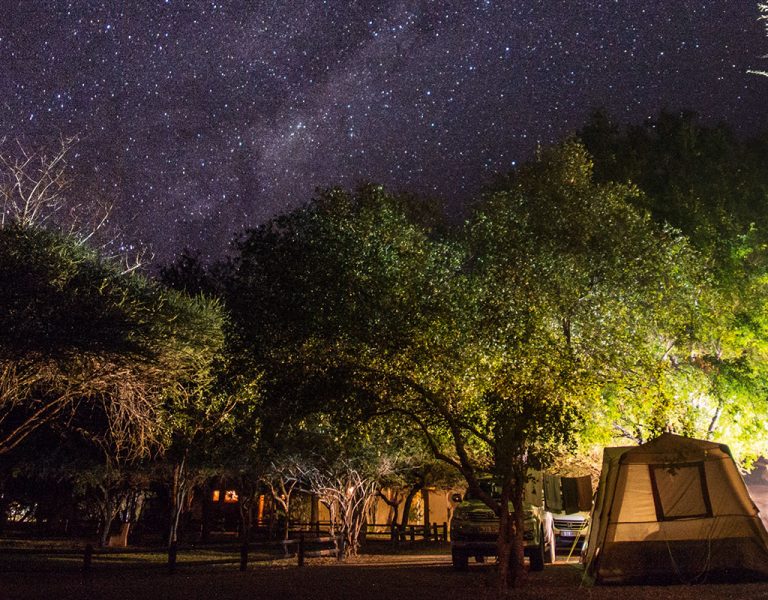
Balule Satellite Camp. Image: Melanie van Zyl
Closest gate: Phalaborwa
Sites 15
Best feasture Stargazing
Special sightings Pel’s fishing owl
Situated almost smack in the middle of Kruger, this is one of the smallest camps in the park (the other is Malelane in the south). Most of the campsites (except for three) are set beside the boundary fence, with a green indigenous garden and lawns below Natal mahogany trees in the middle of the camp.
There’s no electricity here, but there is phone signal and the kitchen and bathroom facilities run on gas. The sites are spacious, and elephants and hyenas often patrol the low fence. It’s a far more open campsite (this also means less shade in places, though) so it’s perfect for stargazing.
Lions and leopards are regularly seen on game drives in the area, and I was lucky enough to see two cheetahs in the nearby Olifants River on a drive north to Letaba.
(An interesting aside, Balule was the only place where people of colour could overnight during the apartheid years.)
Do this Nearby Olifants rest camp offers guided river walks (R300 per person) – a great way to try spot the elusive Pel’s fishing owl.
Plus The bigger Letaba rest camp, with 60 campsites, is also wonderful if you’re one for camping with facilities like a shop and restaurant. There’s also the unbeatable river views, plenty of space to walk if you’re feeling cooped up after long drives, and I love all the wildlife in camp, such as the elegant bushbuck that roam the grounds. It’s great in summer, with a pool and plenty of shade. The stands on the fence close to the Fish Eagle guest house are best for quiet and privacy.
6. Tsendze Campsite
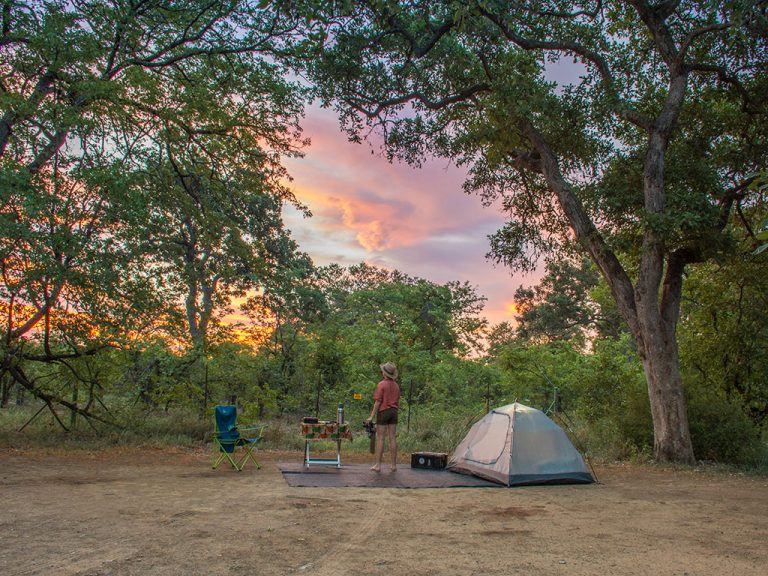
Tsednze Campsite. Image credit: Melanie van Zyl
Closest gate: Phalaborwa
Sites 34
Best feastures
Attention to detail, intimate owl sightings, off-the-grid wildness
Special sightings Rare antelope like roan, tsessebe and eland
Everything is beautifully kept here at Tsendze, thanks to the exceptionally attentive camp management. Rodgers and Elina Hobyane have run this camp for over 10 years and come around personally to every site in the evening, checking on the campers – Elina even fetched me to share the sighting of two lovely pearlspotted owlets tucked into the camp’s mopane trees. Rodgers knows where all the resident owls nest and is happy to show you where they sit in the camp.
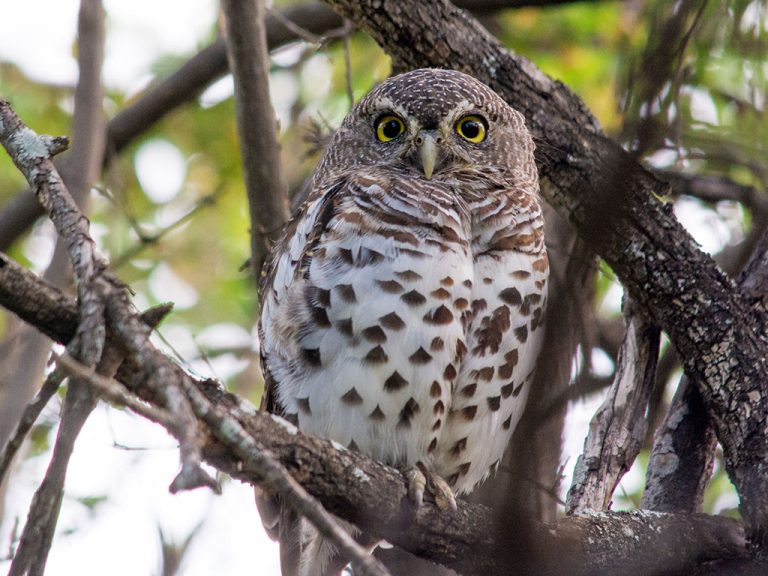
Pearl-spotted owlet. Image: Melanie van Zyl
There are two ablution blocks (with larney outside showers), great kitchen stations with washing-up facilities, gas fridges and cookers, and each site has a spotless braai stand (the cleanest I saw in the park). I camped at number 27, beneath a large apple-leaf tree with clear views through the fence.
Other great options are number 3, 22 and 26, but all sites are spacious and most sit on the boundary with views across the mopaneveld. Tsendze is off the grid, quiet at night and feels like a true piece of wilderness compared to other bigger Kruger camps. It’s also the only camp where you can request a specific site (all others are first come, first served).
Do this Visit the sprawling Pioneer Dam at nearby Mopani rest camp (seven kilometres north) and stretch your legs on the 45-minute boundary walk, keeping your eyes peeled for waterbirds, ellies and crocs.
7. Punda Maria Rest Camp
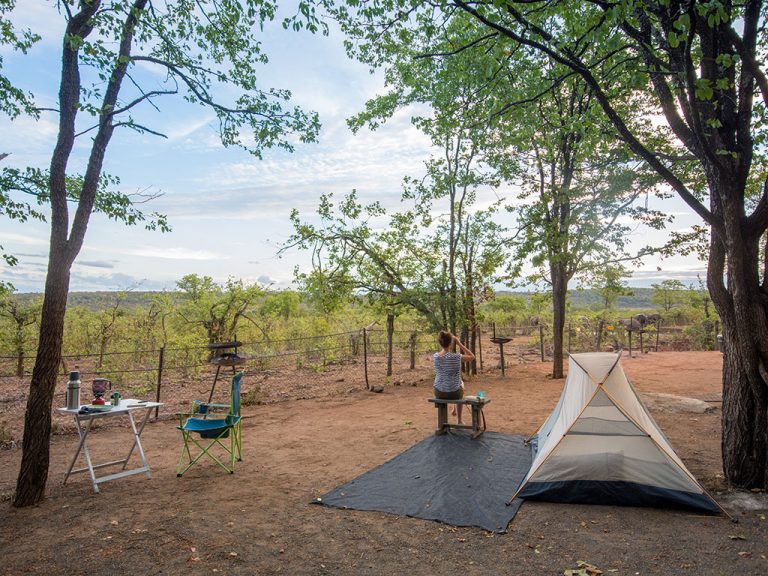
Punda Maria Rest Camp. Image: Melanie van Zyl
Closest gate: Punda Maria
Sites 61
Best feature: The floodlit waterhole and hide
Special sightings Elephants, nyalas, thick-tailed bushbabies
Shingwedzi rest camp in the northeast is also wonderful, but the floodlit hide really sets Punda Maria’s campsite apart. It’s the only camping option in the far north of the park, and also Kruger’s cheapest. Game can prove sparse here but nyalas, kudus, buffalo and elephants (particularly the big tuskers) love this region.
It’s also one of the best areas to search for yellowbilled oxpeckers (once thought extinct in South Africa, but returned to the park in the 1980s). There’s a walking trail through the camp, a swimming pool and ellies are frequent visitors to the waterhole right in front of the campsite. It’s lit up at night, which is how my neighbour managed to spot a slinking leopard who came for a drink just after sundown.
The best sites to the left of the hide have views of this waterhole but get snapped up quickly. Luckily, everyone has access to the hide to enjoy the game that comes to visit. There are resident baboons and vervet monkeys, and everyone will warn you about their mischief. The thick-tailed bushbabies provide no respite, either, as they orchestrate the chaos at night.
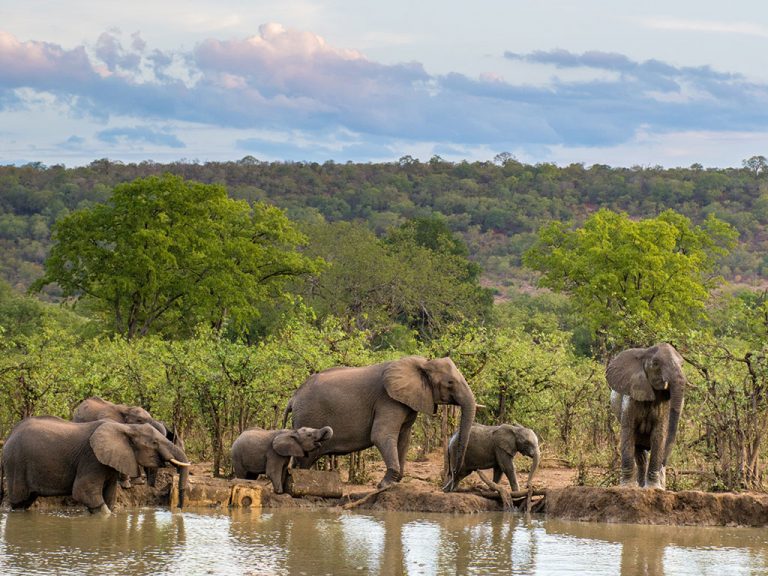
You barely need to creep out of your tent to get this view of the Punda Maria waterhole. Notice the wall supported by old geysers – a necessary quick-fix for a crucial life source. Image: Melanie van Zyl
Do this Drive north when the gates open at sunrise and spend the morning at Luvuvhu Bridge for the best birding. Have breakfast at nearby Pafuri picnic site and drive through the fever-tree forest to Crooks’ Corner, where three countries meet. One can spend several hours in the picnic area with purplecrested turacos, tropical boubous, trumpeter hornbills, Meves’ starlings, Narina trogons and several different species of sunbird and � re� nch to entertain you. The Mahonie Loop just outside camp is also the best in Kruger to see the diminutive suni antelope.
Did you know
Wild dogs are the second-most endangered carnivore in Africa and most endangered in South Africa. From a population of 435 in the mid-1990s to just 132 dogs in 2009, the decision was taken to introduce a new pack of dogs to northern Kruger in the Shingwedzi region.
There’s a lower density of lions in the north, which improves their chances of success, and this will hopefully stimulate the dispersal of packs from south to north in the park. Find the new pack of dogs along the Shingwedzi River – and look for its three-legged member called Foxtrot. If you see any wild dogs, contact Dr Antoine Marchal of the Endangered Wildlife Trust, [email protected].
This article first appeared in the April 2018 issue of Getaway magazine.
Get this issue →
Our April issue features 13 campsites in Kruger National Park, a visit to Vietnam’s capital, Welcome Lishivha returns to Knysna one year after the fires and Melanie Van Zyl finds the best of both worlds in Mauritius, plus lots more.
You may also like
Related Posts
Millions of migrating wildebeest, magical sunsets, incredible wildlife photography and wide open skies make the...
read more
Plan your next local nature escape now. These off-the-grid campsites are serious about reducing your...
read more
For the first time in 150 years, a group of 28 elephants will roam again...
read more